Taller wattles for parks and properties
Acacia baileyana (Cootamundra Wattle)
Native to New South Wales
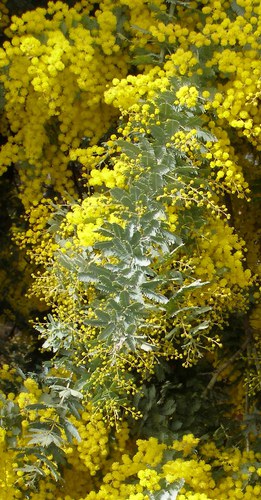
Photo: ©S.D. Searle
Spreading tree to 6-10 m high. Leaves bipinnate, usually bluish green. Flowers in small heads, golden-yellow, appearing Jul-Sep. Moderately frost hardy. This has been a very popular wattle in the past but it is now regarded as undesirable in many areas because of its invasive nature. Frequently planted in south-eastern Australia.
Acacia doratoxylon (Brown Lancewood)
Native to New South Wales, Australian Capital Territory and Victoria
Usually a rounded tree to 10 m high and about the same across. Phyllodes long and narrow, 8-20 cm long and 0.2-1.0 cm wide. Flowers in spikes 2-3 cm long, bright yellow, appearing Sep-Nov. Moderately frost hardy. A slow-growing species suitable for most parts of south-eastern Australia.
Acacia longifolia [includes Acacia sophorae ] (Sydney Golden Wattle, Coast Wattle)
Native to South Australia, Queensland, New South Wales, Victoria and Tasmania.
Erect or spreading tree up to 10 m high and as much as 25 m across in exceptional cases. Phyllodes elliptical, lanceolate or narrow-lanceolate, 5-25 cm long and 1.0-3.5 mm wide. Flowers in spikes 2-5 cm long, golden yellow, appearing Jun-Oct. Moderately frost hardy. This is a species which has been planted in many regions in south-eastern Australia and is often a nuisance. It has become a weed in some places overseas. Particularly suitable for coastal planting.
Acacia acuminata (Raspberry Jam Wattle)
Native to Western Australia
Small tree up to nearly 12 m high or a shrub. Phyllodes long and narrow, from 8-20 cm long and 2-8 mm wide. Flowers in spikes; deep yellow. Moderately frost hardy. Suitable for small gardens in south-western Western Australia and south-eastern Australia, particularly sandy areas.
Acacia falciformis (Broad-leaved Hickory Wattle, Mountain Hickory)
Native to Queensland, New South Wales, Australian Capital Territory and Victoria
Erect tree up to 12 m high. Phyllodes lanceolate or narrow-lanceoate, 8-20 cm long and 2-6 cm wide, sometimes falcate, usually conspicuously grey-green. Flowers in globular heads, pale yellow, appearing Oct-Dec and sometimes other months. Moderately frost hardy. A very hardy tree and suitable for planting in well-drained exposed rocky places in temperate regions.
Acacia aulacocarpa (Brush Ironbark Wattle)
Native to Western Australia, Northern Territory, Queensland and New South Wales and also New Guinea.
Spreading tree occasionally up to 12-15 m high. Phyllodes 8-20 cm long and 2-5 cm wide, more or less falcate. Flowers in spikes, pale golden-yellow, appearing Mar-Jun, rarely later. Not frost hardy. Suitable for tropical and subtropical regions.
Acacia caerulescens (Buchan Blue Wattle)
Native to Victoria
This is a recently described species. Usually an erect tree up to 10-15 m high. Phyllodes usually obovate, 4-8 cm long and 1-3 cm wide, bluish green. Flowers in globular heads, creamy yellow, usually appearing Oct-Nov but sometimes at other times of the year. Moderately frost hardy. Excellent garden subject on account of its foliage. Suitable for south-eastern Australia and particularly limestone sites.
Acacia blayana (Brogo Wattle or Blay’s Wattle)
A rare species known only from the Wadbilliga National Park north-west of Bega, New South Wales.
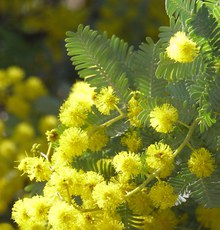
Blay’s Wattle (Acacia blayana) Photo: ©S.D. Searle
Tree up to 25 m high in its native habitat. Leaves bipinnate, large and bluish green. Flowers in large globular heads, golden yellow, appearing Sep-Oct. Moderately frost hardy. It is a recently described species so not much is known about it yet. It is noteworthy for its excellent bluish-green foliage and heavy abundant flowers and should prove an excellent addition to gardens in south-eastern Australia.
Acacia dealbata (Silver Wattle)
Native to New South Wales, Australian Capital Territory, Victoria and Tasmania and it has been introduced into South Australia
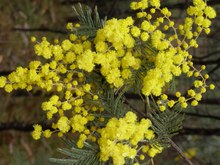
Silver Wattle (Acacia dealbata) Photo: ©S.D. Searle
Tree up to 30 m high with a trunk up to 60 cm in diameter. Leaves bipinnate, usually grey-green. Flowers in small globular heads, creamy yellow, appearing Jul-Oct. Will withstand severe frosts. Suitable for planting in south-eastern Australia. A montane form with very glaucous foliage takes on a shrubby form and is useful for sub-alpine conditions.
Acacia melanoxylon (Blackwood)
Native to South Australia, Queensland, New South Wales, Australian Capital Territory, Victoria and Tasmania
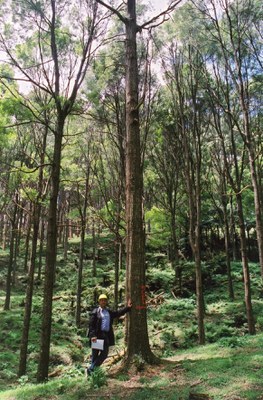
Photo: ©S.D. Searle
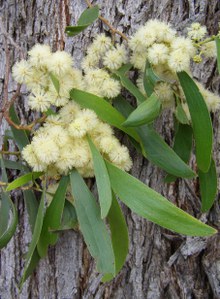
Blackwood (Acacia melanoxylon) leaves, flowers and bark
Photo: ©S.D. Searle
Tree up to 30 m (-45 m) high in its natural habitat but perhaps only 10-15 m in cultivation. Phyllodes lanceolate or narrowly elliptic, 6-12 cm long and 1.0-3.0 cm wide. Flowers in globular heads, pale yellow or cream, appearing during late Jul-Oct. Moderately frost hardy. This is a very hardy long-lived tree.
